 Best Practices Guide to Installing Interior Trim
Best Practices Guide to Installing Interior Trim
Interior trim stock, profiles, materials, MDF trim, urethane trim
- POST a QUESTION or COMMENT about choosing, installing, & troubleshooting interior trim in buildings
Interior trim best practices:
This article describes current choices of materials used for interior woodwork and trim in buildings and gives advice on ordering and using solid wood trim, finger jointed moldings, MDF medium density fiberboard composit trim, urethane moldings and trim, and flexible moldings.
InspectAPedia tolerates no conflicts of interest. We have no relationship with advertisers, products, or services discussed at this website.
- Daniel Friedman, Publisher/Editor/Author - See WHO ARE WE?
Guide to Selecting & Installing Interior Trim: Best Practices
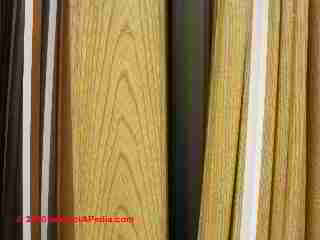 This article series discusses and provides a best construction practices guide to the selection and installation of building interior surface materials, carpeting, doors, drywall, trim, flooring, lighting, plaster, materials, finishes, and sound control materials.
This article series discusses and provides a best construction practices guide to the selection and installation of building interior surface materials, carpeting, doors, drywall, trim, flooring, lighting, plaster, materials, finishes, and sound control materials.
Article Contents
- TRIM, INTERIOR INSTALLATION
- Wide Range of Trim Stock Profiles
- Properties of Hardwoods for Interior Trim
- Standards, Interior Trim: Firsts and Seconds
- Ordering Procedures, Interior Trim
- Custom Profiles, Interior Trim
- Finger-Jointed Moldings, Interior Trim
- Medium Density Fiberboard MDF: Composite Trim
- Urethane Moldings and Interior Trim
- Flexible Moldings as Interior Trim
- Where to buy Interior Trim
As described in the book, Best Practices Guide to Residential Construction (Steve Bliss, J Wiley & Sons) Chapter 5, Interior Finish:
Once the domain of premium softwoods, such as clear pine, poplar, and other easily machined woods, interior trim is just as likely now to contain a mix of finger-jointed stock, medium density fiberboard (MDF) molded urethane for decorative trim, and flexible polyester moldings that must bend around curved surfaces.
Our photo (left) shows the most basic and widely-used budget-trim installed in homes in the U.S. beginning in the 1960's: clamshell trim.
at WINDOW / DOOR AIR LEAK SEALING HOW TO we (D Friedman) describe a project we undertook to remove this clamshell trim, seal gaps around windows and doors, and install custom-cut but elegantly-simple rectangular profile mahogany trim in this home.
Wood moldings and other finish lumber are graded for visual properties only. In general, the higher the grade, the more uniform the grain and color will be, and the fewer the defects, such as small knots, pitch pockets, and other natural markings.
In some species, there is also a marked color difference between heartwood and sapwood. Some customers might like the natural variation found in lower grades; others find it objectionable.
Wide Range of Trim Stock Profiles
Most lumberyards stock only a few molding profiles in pine and even fewer in hardwoods. Specialty molding suppliers, however, offer a far wider variety of stock profiles in both softwoods and common hardwoods.
Molding suppliers also stock a variety of architectural ornaments, such as rosettes and plinth blocks, that can dress up a job or match a traditional style without the cost of custom millwork.
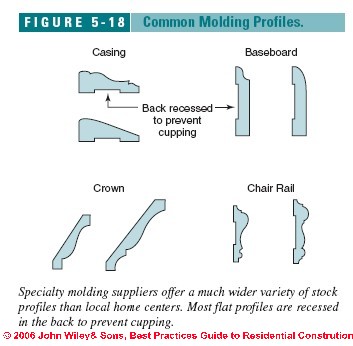
[Click to enlarge any image]
Most wide, flat moldings are recessed or “backed out” a little to reduce the tendency to cup. Cutting kerfs in the back of flat board stock will accomplish the same effect (see Figure 5-18).
Table of Properties of Hardwoods Used for Interior Trim
While some lumberyards stock small quantities of milled hardwood boards and a few molding profiles, most larger jobs require the purchase of rough stock from a hardwood supplier or millwork shop. Hardwood trim characteristics are shown in Table 5-10.
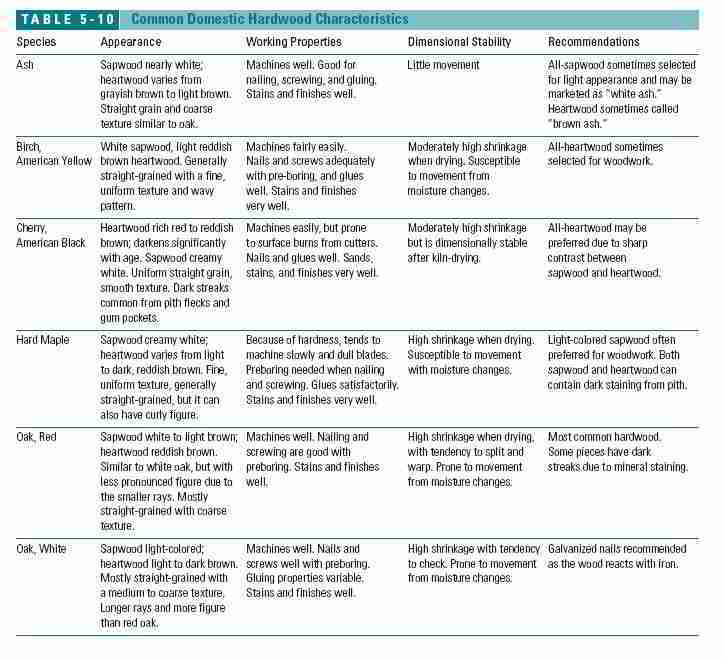
Grading Standards for Interior Trim: FAS "Firsts and Seconds"
If a job requires all clear stock that is “color matched” with minimal color variation from board to board, you will probably need to purchase the highest grade available, often FAS (firsts and seconds), and may still need to cull some pieces. For jobs where more grain variation is acceptable, No. 1 Common or No. 2 and 3 Common may suffice.
FAS is at least 80% clear stock with minimum boards 6 inches wide by 8 to 16 feet long. No. 1 is at least 65% clear with narrower boards, and No. 2 and No. 3 are 50% and 33% clear, respectively.
Ordering Procedures for Interior Trim
Providing the shop with a specific cut list of finished pieces is the best way to guarantee that they deliver the pieces needed for the job. For a premium, you can obtain all-heartwood, all-sapwood, or color-matched boards for uniform color in glue-up work and throughout the job.
Also, the millwork shop can plane the stock on one or both sides, joint one or both edges, and sand one or both faces as needed. Generally, the millwork shop can dress the boards far more economically than a contractor can in the field or in a small shop.
Custom Profiles Available for Interior Trim
A job with hardwood trim may also require profiled moldings, such as baseboard, chair rail, or crown. Custom hardwood moldings require a substantial lead time and a setup fee to make the cutter knives. Many shops keep cutters on hand for standard profiles, as well as custom profiles from prior jobs. Using an existing cutter can significantly cut costs and lead time.
Finger-Jointed or Finger Spliced Wood Moldings Used as Interior Trim
Finger-jointed stock is widely used for paint-grade door and window jambs, as well as profiled moldings.
Finger-jointed stock generally performs well, but in some cases, joints between the individual pieces will “telegraph” through the painted finish due to minute differences in the swelling and shrinking of the individual pieces of wood (see our photo of finger spliced interior trim, looking at the edge of a trim board, below left -DF).
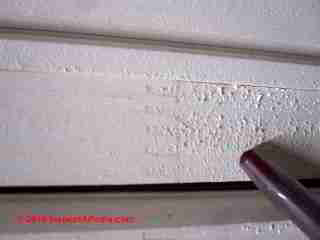

To avoid this problem, sand any uneven joints before applying any finish. Also, back-priming the material will reduce any moisture movement after installation, minimizing problems with telegraphing. While the glued-up finger jointed board connections are quite strong, it is indeed possible to break a board at the finger joint splice, as our second photo shows, above right -DF. But handled with reasonable care, nailed in place, and properly prepped and painted, these joints are virtually impossible to see in interior trim wood.
Finger-jointed exterior trim, unlike its interior trim cousin, is exposed to weather and has proven less durable than hoped at some homes, as illustrated
at TRIM, EXTERIOR CHOICES, INSTALLATION.
MDF: Medium Density Fiberboard Composite Trim: Guide to Selection & Use
Medium-density fiberboard (MDF) is a fine-grained composite material made from wood particles and resin bonded under heat and pressure.
The resin is generally urea-formaldehyde, a known lung irritant, but a few manufacturers offer alternative products made with the more stable phenol formaldehyde or other low-emission resins.
Our photos (below) show the painted-side and back side of composite trim boards on display at a New York Home Depot® store -DF.

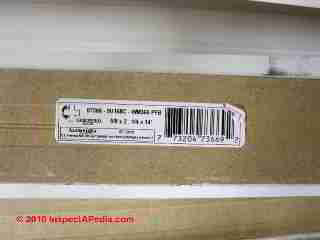
SierraPine Composite Solutions makes Medex, a moisture-resistant MDF product, and Medite II, an interior panel, both using a formaldehyde free resin called MDI (methylene diisocyanate).
In many markets, MDF has become the material of choice for trim and casework due to its low cost, ease of machining, and excellent appearance when painted. It is uniform in consistency and dimensionally stable. MDF trim is available preprimed in a number of standard molding profiles, and 4x8 MDF panels are easy to cut to size and can be routed or shaped to a clean, crisp profile.
However, a 3/4-inch 4x8 panel weighs 95 pounds versus 75 pounds for birch plywood, making MDF sheets a challenge to maneuver.
While MDF offers many benefits, it is not problem free. Cutting and milling creates a super fine dust, which requires workers to wear tight-fitting respirators. Shops should have a good dust-extraction system as well.
The urea-formaldehyde makes the dust more irritating to eyes and lungs and off-gasses to some extent after installation, making the product unacceptable to some (see Chapter 7, “Formaldehyde,” page 287).
Because of hardness, MDF moldings must be installed with pneumatic nailers, which tend to pucker the material around the nail. These “mushrooms” must be chiseled off prior to filling the nail holes.And although it holds paint well, cut and routed edges of MDF will absorb water-based primer and swell.
To avoid these problems, edges of MDF moldings and trim should be sealed with a shellac-based or oil-based primer or painted with special finishes formulated for use with MDF. Due to its potential for absorption at edges, MDF is not a good choice for wet areas. Edge nailing is also not recommended, so MDF is not well suited to applications such as jamb extensions.
See important details at Definition & Characteristics of MDF Medium-Density Fiberboard
Urethane Moldings and Interior Trim - Polyurethane trim;
Although pricey, polyurethane foam moldings (also called polymer moldings) are popular for ornate decorative work.
The leading manufacturer, Fypon, makes a wide range of large crown and cornice moldings, as well as architectural ornaments for mantles, decorative ceilings, and other decorative elements.
Our photos (below) show the face side and back side of primed polyurethane trim sold at a lumber supply store in New York -DF.
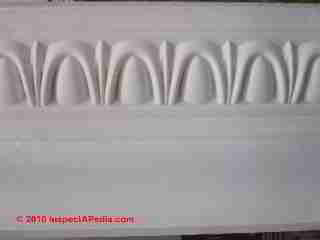
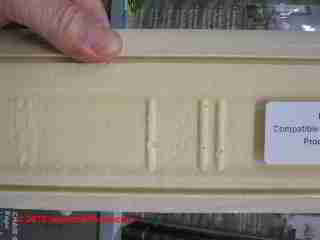
Urethane foam moldings are sold preprimed, and they can be cut, planed, and sanded like wood—only more easily because of their lighter weight.
Urethane trim and moldings are installed with proprietary caulk or adhesive rather than nails, although a few finish nails are often used to hold them in place while the glue dries. Butt joints and miters are bonded with the same adhesive. Larger moldings are limited in length to 10 to 12 feet, requiring multiple joints on long runs.
Flexible Moldings as Interior Trim
Flexible moldings made from dense polyester resin have been available since the late 1960s, but they have improved a lot in recent years.
Newer formulations are easier to nail, more resistant to cracking, and come in a wide variety of profiles, in both paint and stain grades as well as in pre-finished wood-grain patterns (2nd photo from page top -DF, and (Figure 5-19 below).
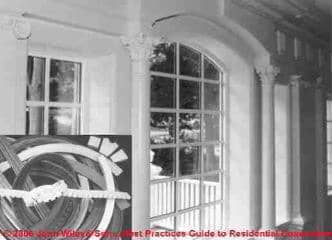
Most manufacturers offer thinner profiles and softer formulations for tighter curves, as well as fire-retardant formulations. Less expensive rigid versions are also available for straight runs. While originally developed for interior use, many of these products are suitable for exterior applications as well.
The stain-grade material has an embossed grain, but must be stained after installation due to the stretching of the surface and requires a heavy pigmented oil-based or gel-type stain with a clear topcoat.
Most flexible moldings are made to order and can perfectly match typical finger-jointed or MDF profiles if specified correctly when ordered—manufacturers have thousands of molds matched to various manufacturers’ stock moldings.
Simple curves such as baseboard or chair rails generally do not need pre forming, but crowns, arch top casings, and most small-radius curves must be preformed by the manufacturer for the specific radius needed. Manufacturers can accommodate ovals, ellipses, and other irregular curves if provided with accurate design specs.
The material cuts easily with standard woodworking tools, but it needs to be held in a jig or sandwiched between wood blocks for difficult cuts. Most manufacturers recommend installation with construction adhesive, panel adhesive, or gel-type super glue, with a few finish nails to hold the molding in place while the glue dries.
Pneumatic pin nailers work well when installing flexible moldings and trim. But ...
Watch out: However, nailing too close to the edge may distort or crack the rubber material. Large moldings such as crown need wood backing or triangular blocks to prevent the molding from bowing in. (see Buy Interior Finish Product Resources for a list of suppliers.)
-- Adapted with permission from Best Practices Guide to Residential Construction (Steve Bliss, J Wiley & Sons) .
Where to Buy Interior Trim Products
Polymer (Urethane / Polyurethane), MDF, and Vinyl Trim Producers & Sources
- AZEK, AZEK TRIM & MOULDING INSTALL GUIDE [PDF] AZEK®Building Products, 1330 W Fulton Street Suite #350,Chicago, IL 60607 USA, including AZEK composite building products such as Timbertch decking and railing, pavers, and trim and moulding AZEK Trimboards Websites: www.azek.com Tel: 877 275 2935 Retrieved 2019/11/04, original source: https://azekexteriors.com/docs/installation/azek_trimmoulding_install_guide.pdf?sfvrsn=4b586f58_28
- Burton Mouldings www.burton-mouldings.com MDF(medium-density fiberboard), polymer, flex, and wood
- Fypon www.fypon.com Polymer moldings and components
- Nu-Wood www.nu-wood.com Polymer moldings and components
- Outwater Plastics www.outwater.com Polymer moldings and components
- RAS Industries www.rasindustries.com Polymer moldings and components
- Royal Mouldings (formerly Marley Mouldings) www.royalmouldings.com Polymer, polystyrene, expanded-PVC, CPVC, and acrylic molding profiles and components
Flexible Trim Manufacturers & Sources
- Flex Trim www.flextrim.com Flexible polymer moldings
- Resin Art www.resinart.com Flexible polymer moldings
-- Adapted with permission from Best Practices Guide to Residential Construction (Steve Bliss, J Wiley & Sons) .
This article includes excerpts or adaptations from Best Practices Guide to Residential Construction (Steve Bliss, J Wiley & Sons) , by Steven Bliss, courtesy of Wiley & Sons. Our page top photo shows chestnut trim in a Poughkeepsie, NY home constructed in 1900 and restored by DJF.
Trim Installation Guides
- TRIM INSTALLATION TIPS & HINTS [PDF] Home Depot Stores, retrived 2019/8/06, original source: https://images.homedepot-static.com/catalog/pdfImages/3e/3ef476b5-eadc-4251-8f64-c51fe80d8868.pdf
...
Reader Comments, Questions & Answers About The Article Above
Below you will find questions and answers previously posted on this page at its page bottom reader comment box.
Reader Q&A - also see RECOMMENDED ARTICLES & FAQs
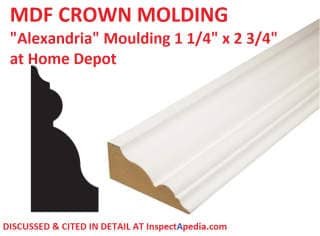 On 2019-08-05 by (mod) - what's the difference between MDF and Fypon trim boards?
On 2019-08-05 by (mod) - what's the difference between MDF and Fypon trim boards?
Jimmy,
Since Fypon produces a wide range of trim type products I infer from your question you're asking about the difference between Fypon™ trim and MDF trim boards.
MDF includes wood fibres or cellulose plus waxes and adhesives in its makeup.
Fypon (trim) is a polyurethane (resin) foam product.
Quoting from our definition of
MDF Medium-Density Fiberboard Definition & Characteristics [above on this page]
MDF (Medium Density Fiberboard) products combine a mixture of wood fibers, a bonding resin, and usually waxes that are combined under high temperature and pressure to produce a medium-density fiberboard product very widely used in the production of trim, cabinets, shelving, and other products, including some products wrapped with an exterior skin of vinyl or plastic to permit outdoor exposure or other uses.
 Fypon™ - is a trade or business name for a specific urethane (resin) product formed into decorative trim (or other building product) produced by Fypon, LLC 1750 Indian Wood Circle, Maumee, OH 43537 USA Website: http://www.fypon.com Tel: (800) 446-3040
Fypon™ - is a trade or business name for a specific urethane (resin) product formed into decorative trim (or other building product) produced by Fypon, LLC 1750 Indian Wood Circle, Maumee, OH 43537 USA Website: http://www.fypon.com Tel: (800) 446-3040
Fypon produces a wide range of products such as balustrades, lightweight decorative "faux-wood" beams, shutters, mouldings, decorative trim, window & door trim such as crossheads, pediments, pilasters, vinyl column wraps.
Fypon Trim:
Here is how the company describes their moulding products:
Material Type: Polyurethane
Product Type: Crown, dentil, decorative, cornice, smooth flat trim, brick, trim, casing, apron, chair rail, baseboard trim, bed, moulding accessories and timber flat trim
Basic Product Information: Moulding to fit any interior style, no unique tools needed for installation, low maintenance with the ability to stain or paint - retrieved 2019/08/05 original source: http://www.fypon.com/products/mouldings.aspx
Definition of polyurethane
Polyurethane is a synthetic resin in which the polymer units are linked by urethane groups, used chiefly as constituents of paints, varnishes, adhesives, and foams. A foam product that's sufficiently hard and rigid, covered with a vinyl or polyurethane or other plastic or resin "skin" can be formed into "trim" boards that are light weight and that (in some formulations) can be used indoors or outside.
Beware that where exposed to high temperatures we sometimes see plastic and urethane foam trim products that are severely deformed, such as around a window or door where the polyurethane foam trim has been painted a dark colour and is exposed to heat and sunlight.
Opinion: having worked with both MDF trim and polyurethane trim both indoors and outdoors I'd say that each has its advantages and its risk points.
Properties of MDF trim vs Polyurethane Trim |
||
| Feature | MDF | Polyurethane |
| Adhesive | Recommended, PVA adhesive | |
| Cutting | Triple-chip carbide finishing blade; Fine toothed handsaw; can be routed. Seal end cuts. Dulls blades quickly. | 80-tooth carbide blade; Cut long, spring into place; |
| Cost | $1.70 / ft. | $1. - $2.50 / ft. |
| Flexibility | More rigid | Easier to fit onto wide radius corves, may pucker |
| Interior/Exterior | Some products only for interior use. |
|
| Nailing | Hand nail or nail gun; Pre-drilling needed if hand-nailing. nailer reduces chipping, size depends on application Puckering may occur at nail heads. |
Glue, Nail, or both; add nails to avoid buckling. Some always require adhesive / glue. Pre-sand surfaces to be glued or glue joints may fail. No pre-drilling needed Hand nail or finish nailer Polyurethane Construction Adhesive |
| Painting | Yes, pre-primed. Don't use traditional wood stains. | Yes, pre-primed. Use a glaze or gel stain or use Acrylic Latex or Oil based paint Resin-based flexible moulding does not accept wood stains. Gel type stains from Minwax, WoodKote, Jel'd Stain, or Zaro will work. |
| Shrinkage | Minimize by gluing, end gluing, proper nailing or stapling | Uncommon |
| Temperature | Stiffens below 60°F, remains nailable. | |
| Variety of Form | Predominantly panels & trim; | More extensive, e.g. medallionis |
| Moisture & Weather Resistance | Absorbs moisture, protect from weather, acclimate to jobsite. Industry standard: 0.3% expansion/contraction in response to RH variation beween 40 RH & 80 RH. |
Low moisture uptake, May warp in high heat. |
| Weight | Heavier than polyurethane. 3/4" thick MDF weighs 3.2 lbs per sq.ft. 3/4" thick ultralight MDF (Trupan) weighs 2.5 lbs. per sq.ft. |
Very lightweight. 3 1/2" Crown molding, 1.25 oz. / ft. Half or less the weight of MDF.
|
Notes to the table above:
Trim Board Weight Details
- Angelo [Polyurethane] Foam Crown Molding, 10 oz. per 8 ft. length (Amazon 2019/08/06)
- Mouldex Moulidngs, plaster covered foam core moulding products 170 Pippin Road
Vaughan, Ontario
L4K - 4X9
CANADA Ph: (905) 660-6338
1 (888) MOULDEX
Fax: (905) 660-6350
info[@]mouldexmouldings.com Website: https://www.mouldexmouldings.com/, some products rated for exterior use: Exterior EPS foamcore moldings for stucco, brick, stone
Plaster coated foam core mouldings combine an EPS core (styrofoam or expanded polystyrene), a synthetic fiber mesh, a foundation coat, fine coat, and final finish coat of cement and plaster.
Trim Board Cost Comparisons using Crown Moulding as an example
These cost comparisons are just approximate; per foot costs vary by moulding width and profile, type of priming, & other features.
- Common pine, primed, finger-jointed, $1.50 / ft. - $2. / ft. (EverTrue, Lowes 2019/08/06)
- Hardwood, primed, $2. - $20. / ft (Lowes 2019/08/06)
- MDF Crown Moulding, $1.70 / ft. (EverTrue primed MDF Lowes 2019/08/06)
- Plaster-covered foam: $3.75 / ft
- Plaster moulding: $5. / ft. and up; 4" hand carved plaster crown molding: $18.75 / ft. (DecoCraft USA at Amazon 2019/08/06) - install with glue & exterior screws.
- Polyurethane flexible moulding: $1. / ft. to $2.50 / ft. (Ekena Millwork 4" x 7.77 ft. polyurethane Crown Moulding, Lowes 2019/08/06)
- Polystyrene crown molding: $1.25 / ft. (Interplast Group Bldg Prods, Lowes 2019/08/06)
References for Installation of MDF vs Polyurethane Trim Mouldings
- Separately at MDF MEDIUM DENSITY FIBERBOARD Definition & Characteristics - details we give the detailed properties of MDF, and we include information about MDF offgassing issues, MDF color codes,
Also see SIDING HARDBOARD IDENTIFICATION & CLAIMS - American Pro Decor POLYURETHANE CROWN MOULDINGS INSTALLATION GUIDE [PDF] retrieved 2019/08/05 original source: https://images.homedepot-static.com/catalog/pdfImages/5d/5dfe9741-7bb1-43de-8406-d5dbb3e1dda3.pdf
- Arauco TruChoice MDF MOULDINGS GENERAL INSTALLATION INSTRUCTIONS [PDF] retrieved 2019/08/05 original source: https://images.homedepot-static.com/catalog/pdfImages/75/75e2340c-7466-4e2e-99fb-12feda897de2.pdf Manufacturer's website: http://web.truchoicemoulding-na.com/ or Email: panels@arauco.cl
- PacTrim PacTrim MDF Interior Use Trim General Installation Instructions [PDF] PacTrim, Pacific MDF Products, Inc., 4312 Anthony Ct
Rocklin, CA 95677 USA: 1-800-472-2874 or Canadian MDF Products Co, Alberta CA, Tel: 1-866-226-8746 retrieved 2019/08/05 original source: http://pactrim.com/how-to-use/
Website Excerpt: Pacific MDF Products has grown to be the largest manufacturer of interior MDF mouldings in North America. - Ultra-Flex Moulding, Syntatic polyurethane Ultimate Flex pre-primed mouldings, Ultra-Flex Molding Co., Email: info@ultraflexmoulding.com Website http://www.ultraflexmoulding.com does not give company location nor telephone.
- POLYMER MOLDING TRIM & building DETAILS as exterior building trim & features
- CELLULAR PVC TRIM MOLDINGS as exterior building trim & features
On 2019-08-05 by Jimmy - what's Different between Fypon & MDF material ?
Different between Fypon MDF material
...
Continue reading at TRIM, INTERIOR - topic home, or select a topic from the closely-related articles below, or see the complete ARTICLE INDEX.
Or see these
Recommended Articles
Suggested citation for this web page
TRIM, INTERIOR INSTALLATION at InspectApedia.com - online encyclopedia of building & environmental inspection, testing, diagnosis, repair, & problem prevention advice.
Or see this
INDEX to RELATED ARTICLES: ARTICLE INDEX to BUILDING INTERIORS
Or use the SEARCH BOX found below to Ask a Question or Search InspectApedia
Ask a Question or Search InspectApedia
Questions & answers or comments about choosing, installing, & troubleshooting interior trim in buildings.
Try the search box just below, or if you prefer, post a question or comment in the Comments box below and we will respond promptly.
Search the InspectApedia website
Note: appearance of your Comment below may be delayed: if your comment contains an image, photograph, web link, or text that looks to the software as if it might be a web link, your posting will appear after it has been approved by a moderator. Apologies for the delay.
Only one image can be added per comment but you can post as many comments, and therefore images, as you like.
You will not receive a notification when a response to your question has been posted.
Please bookmark this page to make it easy for you to check back for our response.
IF above you see "Comment Form is loading comments..." then COMMENT BOX - countable.ca / bawkbox.com IS NOT WORKING.
In any case you are welcome to send an email directly to us at InspectApedia.com at editor@inspectApedia.com
We'll reply to you directly. Please help us help you by noting, in your email, the URL of the InspectApedia page where you wanted to comment.
Citations & References
In addition to any citations in the article above, a full list is available on request.
- Steve Bliss's Building Advisor at buildingadvisor.com helps homeowners & contractors plan & complete successful building & remodeling projects: buying land, site work, building design, cost estimating, materials & components, & project management through complete construction. Email: info@buildingadvisor.com
Steven Bliss served as editorial director and co-publisher of The Journal of Light Construction for 16 years and previously as building technology editor for Progressive Builder and Solar Age magazines. He worked in the building trades as a carpenter and design/build contractor for more than ten years and holds a masters degree from the Harvard Graduate School of Education. Excerpts from his recent book, Best Practices Guide to Residential Construction, Wiley (November 18, 2005) ISBN-10: 0471648361, ISBN-13: 978-0471648369, appear throughout this website, with permission and courtesy of Wiley & Sons. Best Practices Guide is available from the publisher, J. Wiley & Sons, and also at Amazon.com - Our recommended books about building & mechanical systems design, inspection, problem diagnosis, and repair, and about indoor environment and IAQ testing, diagnosis, and cleanup are at the InspectAPedia Bookstore. Also see our Book Reviews - InspectAPedia.
- In addition to citations & references found in this article, see the research citations given at the end of the related articles found at our suggested
CONTINUE READING or RECOMMENDED ARTICLES.
- Carson, Dunlop & Associates Ltd., 120 Carlton Street Suite 407, Toronto ON M5A 4K2. Tel: (416) 964-9415 1-800-268-7070 Email: info@carsondunlop.com. Alan Carson is a past president of ASHI, the American Society of Home Inspectors.
Thanks to Alan Carson and Bob Dunlop, for permission for InspectAPedia to use text excerpts from The HOME REFERENCE BOOK - the Encyclopedia of Homes and to use illustrations from The ILLUSTRATED HOME .
Carson Dunlop Associates provides extensive home inspection education and report writing material. In gratitude we provide links to tsome Carson Dunlop Associates products and services.

